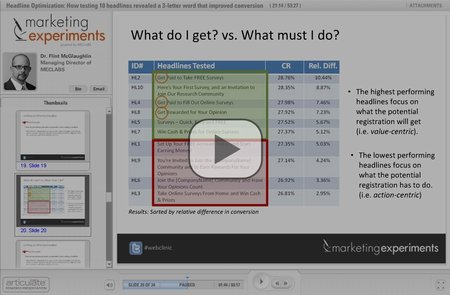Last updated on July 26th, 2011
Recently, I had the pleasure of once again watching a webinar from Marketing Experiments, this time on headline optimization. The research firm, who also produces Marketing Sherpa, regularly shares their findings with online marketers to help us perfect our craft.
For this webinar, the research team at Marketing Experiments focused on headlines.
Headlines constitute the most important part of your site’s copy – landing pages in particular must have a strong headline in order to grab the reader’s interest. In the fast paced world of online marketing, you must construct a headline that succinctly describes what your page is about and what the reader can expect by reading more.
Headlines are also perhaps the easiest (…and most important) thing to change on a webpage. So if your site is loaded with landing pages, it shouldn’t take hours of your time to make some minor tweaks.
Doing so could result in dramatically more conversions, which is the holy grail of any webpage you post on your site.
In ME’s webinar, the team organized headlines from highest performing to lowest, which reveals certain patterns marketers can take away.
One such pattern is the more top-performing headlines emphasize what the reader will get by reading more. In technical terms, this is what ME calls a ‘value-centric’ headline. The other noticeable pattern for top-performing headlines is ones where the value point was positioned at the beginning of the headline.
Consider the following example from the webinar:
Get Paid to Take FREE Surveys vs. Take Online Surveys from Home
Which headline do you think saw more conversions?
According to the data, the first headline experienced over twice the amount of conversions because it emphasized what the reader will get.
From analyzing conversion data for 10 different headlines, the team at Marketing Experiments was able to derive two key principles to keep in mind when crafting your landing page headlines.
1. Interests of the customer must be the central focus of all headlines and marketing messages. Emphasize what the reader will get rather than what they must do.
2. Headlines can be compared to the opening scene of a movie in that each must ‘arrest’ the visitor’s attention at the beginning.
When considering these two principles, it’s best to use what ME calls a ‘point-first’ structure, meaning you place the value of what you offer right at the beginning of the headline.
One interesting comparison to consider, especially if you’re a guy trying to write landing pages, is the similarity between headlines and ‘pick-up’ lines. Every guy knows you can’t get the girl’s phone number immediately. You have to draw their interest and start a conversation, which is exactly what headlines and landing pages do.
That’s why you can’t rush your call-to-action. You can’t have a conversation before your opening line. And you can’t get someone to do something without having that conversation, which is exactly like trying to talk a girl you really like.
So to really develop headlines that work, use a ‘point-first’ structure and place the value of what you offer the reader at the very beginning.
Click the image below and watch the webinar for more. Or click here to see the webinar in other formats. And feel free to let us know how this works for you. We’ll be changing a few headlines here and there and report back on our own findings.

Related Posts
Maximize Conversions by Following These 9 Steps for Writing the Ultimate Landing Page
Eyetracking Study Reveal Users Read Webpages in an F-Shaped Pattern
Test Headlines with the “Breath” Test
